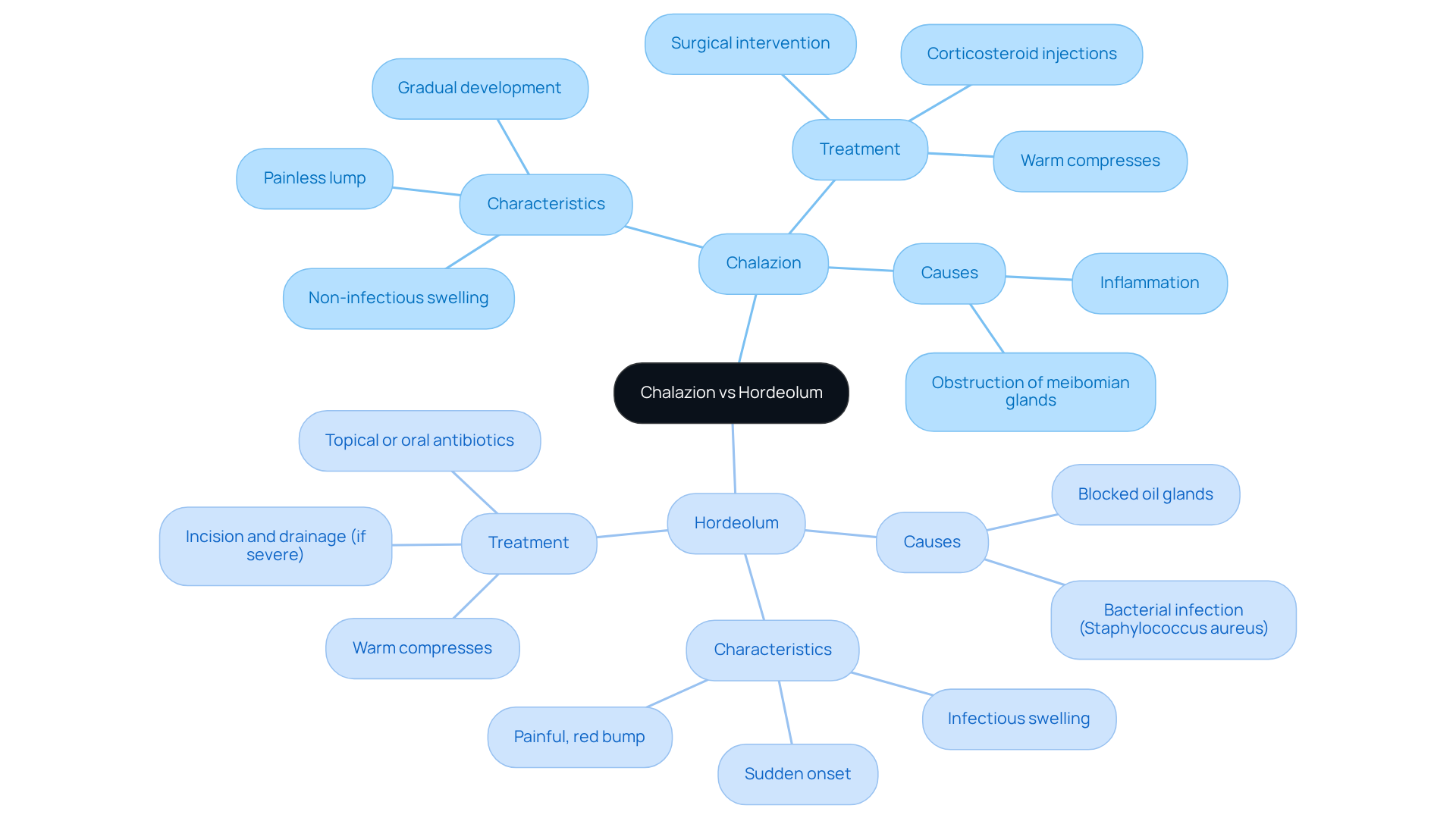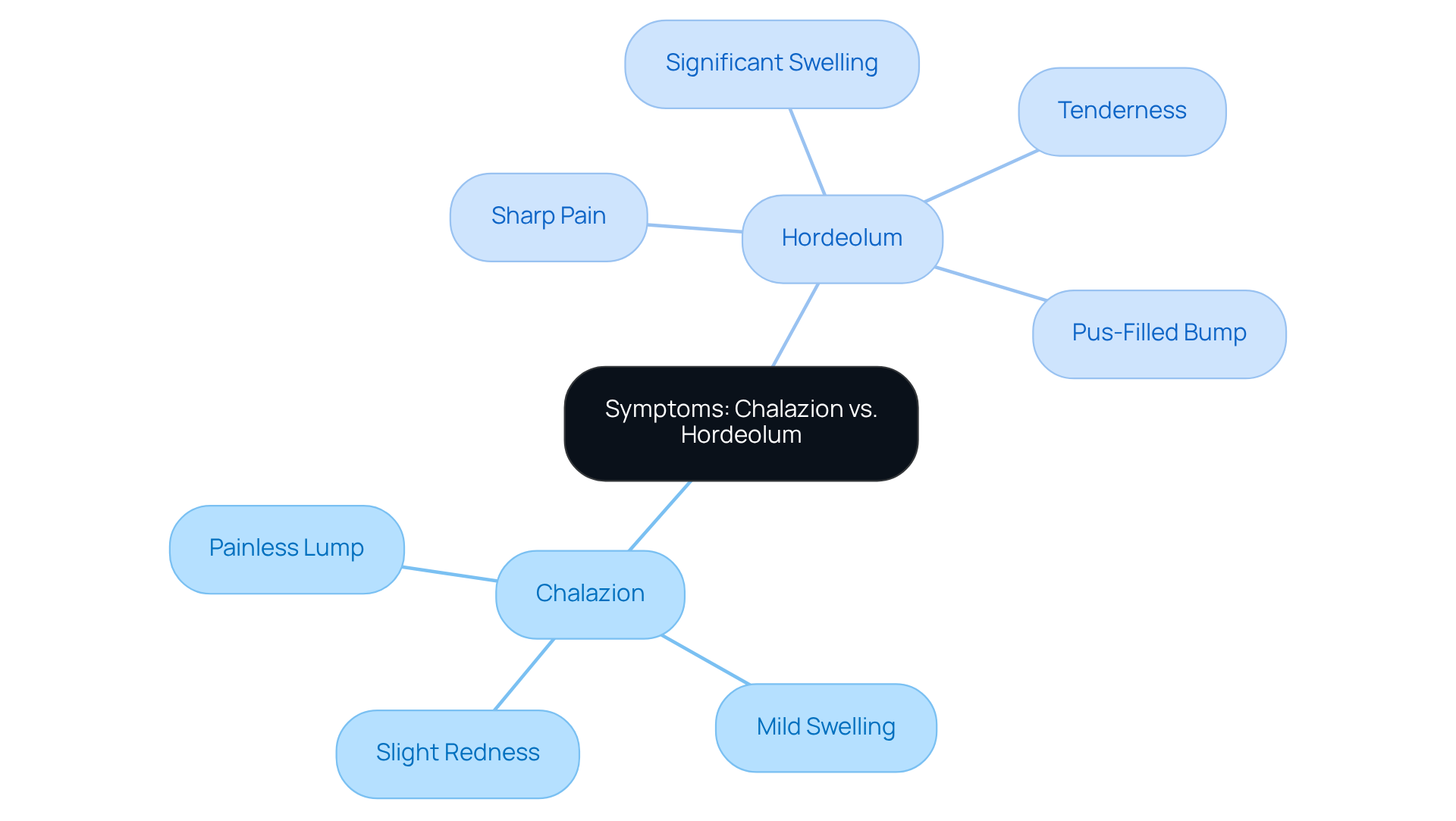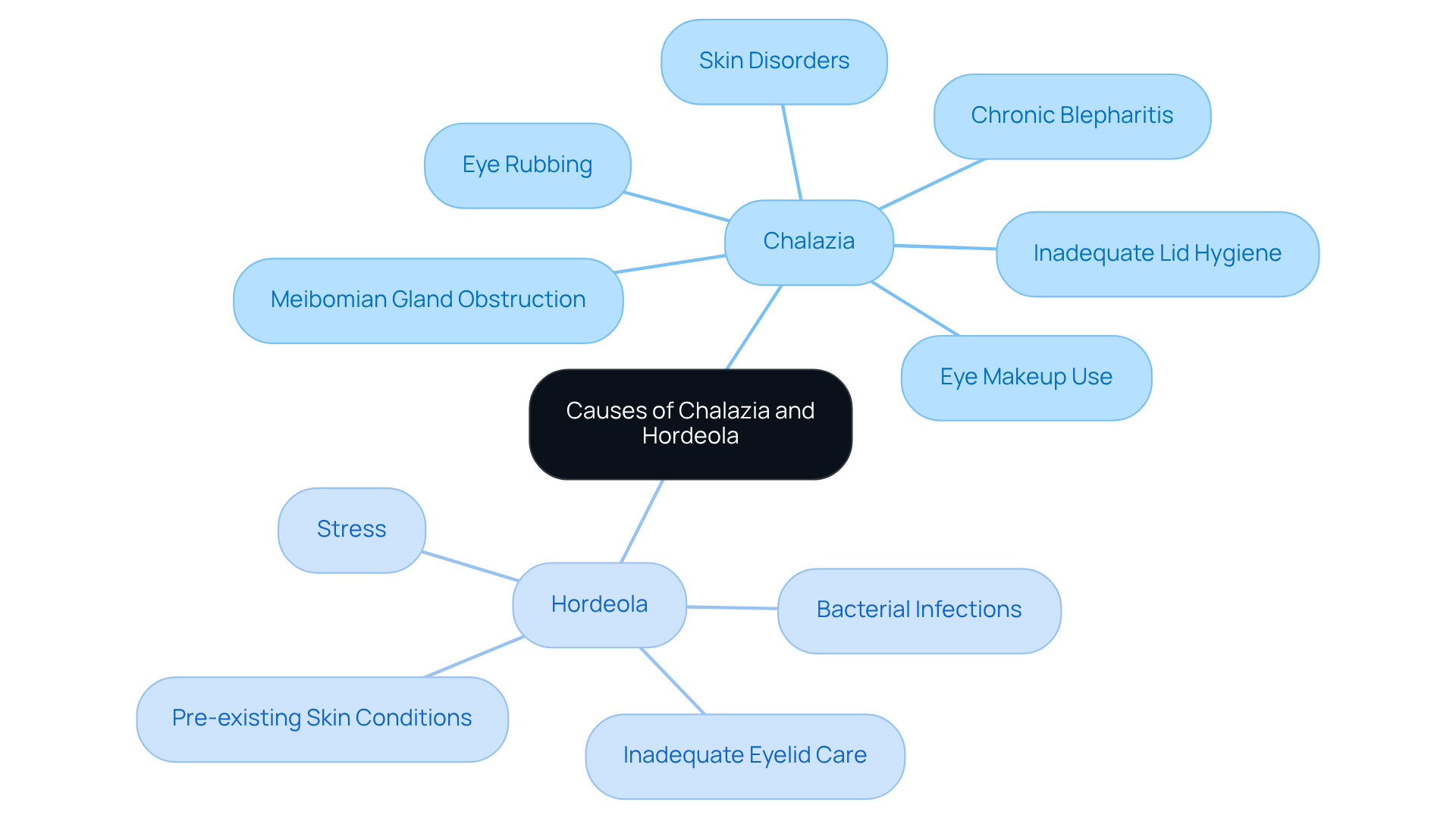Posted by: Northwest Eye in General on July 9, 2025
Overview
Understanding the differences between chalazion and hordeolum is important for your health and peace of mind. Chalazia are non-infectious and painless lumps that occur due to blocked glands, while hordeola are painful, infectious bumps caused by bacterial infections. We understand that it can be concerning to face these conditions, and recognizing their distinct characteristics can help ease your worries.
It’s crucial to know that treatment options vary significantly for each condition. Chalazia often require surgical intervention, which may sound daunting, but rest assured that this is a common procedure. On the other hand, hordeola typically resolve with conservative care, such as warm compresses, which can be comforting and effective.
By understanding these distinctions, you can take proactive steps towards accurate diagnosis and effective management. We are here to help you through this process and ensure that you receive the best care possible.
Introduction
Understanding the differences between a chalazion and a hordeolum is essential for anyone experiencing eyelid bumps. We understand that encountering these conditions can cause discomfort and concern. While both issues arise from distinct causes, they require different treatment approaches. This article aims to provide clarity on the key differences, symptoms, and management strategies for these common eyelid issues.
How can one accurately identify these conditions to ensure appropriate care and avoid complications? We are here to help you through this process.
Define Chalazion and Hordeolum: Key Differences
A chalazion is a persistent, non-infectious swelling that can understandably cause concern. It arises when a meibomian gland in the eye region becomes obstructed, leading to a solid, painless bump. In contrast, a hordeolum, commonly known as a stye, is an , resulting in a that may contain pus. We understand that these symptoms can be alarming.
While cysts develop gradually and are typically painless, appear suddenly and are often accompanied by . This distinction of is crucial for , as the underlying causes and management strategies differ significantly between the two conditions. Recent studies indicate that eyelid bumps are more prevalent in adults aged 30-50, particularly among females, who represent 68.2% of diagnosed cases. Conversely, younger individuals are more prone to eyelid bumps, primarily caused by Staphylococcus aureus infections, with over 90% of cases connected to this bacterium.
Comprehending these distinctions is essential for efficient management. For example, in the discussion of [chalazion vs hordeolum](https://ucfhealth.com/our-services/ophthalmology/chalazion-vs-hordeolum):
- Chalazia may necessitate .
- Hordeola generally clear up within a week with suitable care, such as warm compresses.
It’s common to feel anxious about treatment options, but rest assured that accurate diagnosis is vital to avoid complications. Misdiagnosis can lead to unnecessary treatments or delayed care, which we are here to help you navigate. Remember, you are not alone in this process.

Compare Symptoms: Chalazion vs. Hordeolum
Chalazia often present as located deeper within the eyelid. While they may cause slight discomfort, this usually occurs only if they grow large enough to press against the eyeball. Common symptoms include mild swelling and slight redness. In contrast, can lead to sharp pain, , and noticeable redness at the eye’s margin, often accompanied by tenderness and a pus-filled bump. Many patients also report tearing and a feeling of something foreign in their eye.
We understand that these symptoms can be concerning, especially since they may also indicate other conditions like conjunctivitis, allergies, or infections, which can lead to sore, red, and itchy eyes. Recognizing these symptoms is essential, as it directly influences the urgency and type of treatment needed. If left untreated, these symptoms can result in serious health complications, making it crucial to seek .
Recent studies emphasize the importance of in for more effective management strategies. Ophthalmologists stress the value of accurate self-diagnosis to ensure . Regular are vital, particularly for children, to monitor and address any potential issues early. Remember, we are here to help you through this process, and seeking care is an important step toward maintaining .

Examine Causes: Triggers for Chalazia and Hordeola
Chalazia can be concerning, often occurring due to the obstruction of meibomian glands. This condition may arise from inadequate , chronic blepharitis, or skin disorders like rosacea. We understand that can worsen these issues, potentially leading to the formation of chalazia.
In contrast, styes are typically caused by bacterial infections, particularly from Staphylococcus aureus, which infect the oil glands of the eye. It’s common to feel worried about these conditions, especially when considering the key , such as inadequate eyelid care, stress, and pre-existing skin conditions.
is crucial for . Both can significantly impact and comfort, and we are here to help you through this process. Remember, seeking care and addressing these concerns can lead to better outcomes for your .

Evaluate Treatment Options: Managing Chalazion and Hordeolum
Management for eyelid cysts often begins with . We understand that dealing with these issues can be concerning, so applying to the eyelid for 10 to 15 minutes several times a day can be very helpful. This method promotes drainage and frequently leads to resolution. In fact, studies show that most chalazia respond well to this technique within a month, illustrating the differences in treatment outcomes in the context of .
If conservative care does not yield results, we may need to consider options like:
- Intralesional corticosteroid injections
It’s important to note that styes are usually treated with warm compresses and maintaining . If an infection is suspected, might be prescribed, and in more severe cases, oral antibiotics could be necessary.
For , especially when considering chalazion vs hordeolum, surgical intervention may be appropriate if they do not respond to medical care. Understanding these treatment pathways is crucial for and optimal recovery. Remember, can significantly improve your outcomes. We are here to help you through this process, ensuring you receive the care and support you need.
Conclusion
Understanding the differences between chalazia and hordeola is essential for effective eye care. We recognize that encountering bumps on the eyelid can be concerning, and knowing how to differentiate between these conditions can help ease your worries. While both may appear similar, their causes, symptoms, and treatment approaches vary significantly. Recognizing these distinctions empowers you to seek appropriate medical attention and avoid unnecessary anxiety.
Chalazia are characterized by painless, solid lumps due to blocked meibomian glands. They often require conservative management, such as warm compresses. On the other hand, hordeola, commonly known as styes, present with painful, red bumps caused by bacterial infections. These typically resolve with proper hygiene and care. It’s important to understand the underlying causes of these conditions to inform your treatment decisions, ensuring timely intervention.
Ultimately, being informed about chalazia and hordeola can lead to better eye health outcomes. We encourage you to seek professional advice if you experience symptoms, as proper diagnosis and treatment are vital for recovery. Embracing proactive eye care practices can significantly enhance your comfort and well-being. Remember, you are not alone in this journey; we are here to help you through the process, underscoring the importance of awareness in managing these common eyelid conditions.
Frequently Asked Questions
What is a chalazion?
A chalazion is a persistent, non-infectious swelling that occurs when a meibomian gland in the eye region becomes obstructed, resulting in a solid, painless bump.
What is a hordeolum?
A hordeolum, commonly known as a stye, is an acute bacterial infection of the eyelid’s oil glands, leading to a painful, red bump that may contain pus.
How do chalazia and hordeola differ in terms of symptoms?
Chalazia develop gradually and are typically painless, while hordeola appear suddenly and are often accompanied by significant discomfort and inflammation.
Why is it important to distinguish between chalazion and hordeolum?
The distinction is crucial for proper diagnosis and treatment, as the underlying causes and management strategies differ significantly between the two conditions.
Who is more likely to experience eyelid bumps?
Recent studies indicate that eyelid bumps are more prevalent in adults aged 30-50, particularly among females, who represent 68.2% of diagnosed cases. Younger individuals are also prone to eyelid bumps, mainly caused by Staphylococcus aureus infections.
What are the treatment options for chalazion and hordeolum?
Chalazia may require surgical intervention if conservative approaches are inadequate, while hordeola generally clear up within a week with appropriate care, such as warm compresses.
What should I do if I experience symptoms of chalazion or hordeolum?
It is essential to seek an accurate diagnosis to avoid complications, as misdiagnosis can lead to unnecessary treatments or delayed care.






